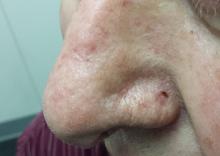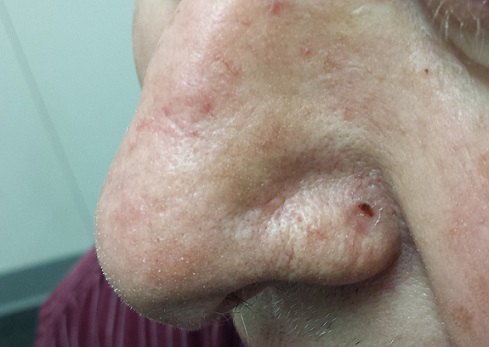User login
At first, this 70-year-old man thought the lesion on his nose was a pimple, although it seemed oddly resilient. When he attempted to pop it, nothing came out.
When it not only failed to heal but also grew over a six-month period, he finally decided to consult his primary care provider (PCP). The PCP told him not to worry about it but offered to refer him to dermatology—mostly because the patient’s wife was concerned.
The patient gives a history of extensive sun exposure in childhood and young adulthood. In the 1960s, he was drafted into the military and served two tours of duty in the jungles of Vietnam, where he acquired an almost permanent sunburn.
EXAMINATION
The patient is quite fair, with modest facial sun damage manifesting as telangiectasias and solar elastosis. The lesion in question is a glassy, scarlike, concave papule with a scab at one end. It is located in the left alar groove and measures about 5 mm in diameter.
Under local anesthesia, the lesion is biopsied and sent to pathology.
What is the diagnosis?
DISCUSSION
The pathology report indicated basal cell carcinoma (BCC). Given the location, the patient was referred to a Mohs surgeon, who needed two passes to clear the site of cancer. Closure of the resulting 2.5-cm defect required a skin graft, using the postauricular neck as the donor site. Afterward, the PCP, the patient, and his wife all expressed astonishment that such a tiny lesion had required so complex a procedure.
BCC is, by far, the most common of the sun-caused skin cancers, with more than a million new cases diagnosed in the US each year. While rarely dangerous, BCCs can be highly destructive of local structures (eyelids, noses, ears, faces) if left untreated for extended periods. Virtually all BCCs grow relentlessly, but some are more aggressive than others—a trait confirmed not only by the behavior of the cancer, but also, in some cases, by characteristic histologic findings.
Location has a major impact on the behavior of a given BCC. The posterior portion of the nose (alar groove) is particularly prone to harbor more extensive and aggressive BCCs.
Given the additional cosmetic implications of removing cancers from this area, these often require Mohs surgery to ensure complete, mircroscopically controlled removal of the cancer, as well as closure of the wound in a cosmetically acceptable manner.
Some aggressive types of BCC will require radiation therapy even after Mohs or conventional surgical removal. Fortunately, deaths from BCCs usually result from local invasion and not from metastasis, which is extremely rare.
For providers, the key is a low threshold for the necessity of biopsy. Simple shave biopsy is usually adequate. When PCPs are uncomfortable performing such biopsies, expedited referral to dermatology is called for.
TAKE-HOME LEARNING POINTS
• BCC is the most common of the sun-caused skin cancers, with more than a million new cases diagnosed every year in the US.
• While they rarely metastasize, BCCs can result in extensive invasion of local structures (eg, bone, cartilage, and even brain).
• Some BCCs are more aggressive than others in terms of demonstrated biologic activity.
• Some anatomical locations are themselves predictors of increased biologic activity; the nose is a prime example of this phenomenon.
• Mohs surgery—named after Frederic Mohs, MD, who pioneered the concept—ensures complete removal of the cancer and provides cosmetically acceptable closure as well.
At first, this 70-year-old man thought the lesion on his nose was a pimple, although it seemed oddly resilient. When he attempted to pop it, nothing came out.
When it not only failed to heal but also grew over a six-month period, he finally decided to consult his primary care provider (PCP). The PCP told him not to worry about it but offered to refer him to dermatology—mostly because the patient’s wife was concerned.
The patient gives a history of extensive sun exposure in childhood and young adulthood. In the 1960s, he was drafted into the military and served two tours of duty in the jungles of Vietnam, where he acquired an almost permanent sunburn.
EXAMINATION
The patient is quite fair, with modest facial sun damage manifesting as telangiectasias and solar elastosis. The lesion in question is a glassy, scarlike, concave papule with a scab at one end. It is located in the left alar groove and measures about 5 mm in diameter.
Under local anesthesia, the lesion is biopsied and sent to pathology.
What is the diagnosis?
DISCUSSION
The pathology report indicated basal cell carcinoma (BCC). Given the location, the patient was referred to a Mohs surgeon, who needed two passes to clear the site of cancer. Closure of the resulting 2.5-cm defect required a skin graft, using the postauricular neck as the donor site. Afterward, the PCP, the patient, and his wife all expressed astonishment that such a tiny lesion had required so complex a procedure.
BCC is, by far, the most common of the sun-caused skin cancers, with more than a million new cases diagnosed in the US each year. While rarely dangerous, BCCs can be highly destructive of local structures (eyelids, noses, ears, faces) if left untreated for extended periods. Virtually all BCCs grow relentlessly, but some are more aggressive than others—a trait confirmed not only by the behavior of the cancer, but also, in some cases, by characteristic histologic findings.
Location has a major impact on the behavior of a given BCC. The posterior portion of the nose (alar groove) is particularly prone to harbor more extensive and aggressive BCCs.
Given the additional cosmetic implications of removing cancers from this area, these often require Mohs surgery to ensure complete, mircroscopically controlled removal of the cancer, as well as closure of the wound in a cosmetically acceptable manner.
Some aggressive types of BCC will require radiation therapy even after Mohs or conventional surgical removal. Fortunately, deaths from BCCs usually result from local invasion and not from metastasis, which is extremely rare.
For providers, the key is a low threshold for the necessity of biopsy. Simple shave biopsy is usually adequate. When PCPs are uncomfortable performing such biopsies, expedited referral to dermatology is called for.
TAKE-HOME LEARNING POINTS
• BCC is the most common of the sun-caused skin cancers, with more than a million new cases diagnosed every year in the US.
• While they rarely metastasize, BCCs can result in extensive invasion of local structures (eg, bone, cartilage, and even brain).
• Some BCCs are more aggressive than others in terms of demonstrated biologic activity.
• Some anatomical locations are themselves predictors of increased biologic activity; the nose is a prime example of this phenomenon.
• Mohs surgery—named after Frederic Mohs, MD, who pioneered the concept—ensures complete removal of the cancer and provides cosmetically acceptable closure as well.
At first, this 70-year-old man thought the lesion on his nose was a pimple, although it seemed oddly resilient. When he attempted to pop it, nothing came out.
When it not only failed to heal but also grew over a six-month period, he finally decided to consult his primary care provider (PCP). The PCP told him not to worry about it but offered to refer him to dermatology—mostly because the patient’s wife was concerned.
The patient gives a history of extensive sun exposure in childhood and young adulthood. In the 1960s, he was drafted into the military and served two tours of duty in the jungles of Vietnam, where he acquired an almost permanent sunburn.
EXAMINATION
The patient is quite fair, with modest facial sun damage manifesting as telangiectasias and solar elastosis. The lesion in question is a glassy, scarlike, concave papule with a scab at one end. It is located in the left alar groove and measures about 5 mm in diameter.
Under local anesthesia, the lesion is biopsied and sent to pathology.
What is the diagnosis?
DISCUSSION
The pathology report indicated basal cell carcinoma (BCC). Given the location, the patient was referred to a Mohs surgeon, who needed two passes to clear the site of cancer. Closure of the resulting 2.5-cm defect required a skin graft, using the postauricular neck as the donor site. Afterward, the PCP, the patient, and his wife all expressed astonishment that such a tiny lesion had required so complex a procedure.
BCC is, by far, the most common of the sun-caused skin cancers, with more than a million new cases diagnosed in the US each year. While rarely dangerous, BCCs can be highly destructive of local structures (eyelids, noses, ears, faces) if left untreated for extended periods. Virtually all BCCs grow relentlessly, but some are more aggressive than others—a trait confirmed not only by the behavior of the cancer, but also, in some cases, by characteristic histologic findings.
Location has a major impact on the behavior of a given BCC. The posterior portion of the nose (alar groove) is particularly prone to harbor more extensive and aggressive BCCs.
Given the additional cosmetic implications of removing cancers from this area, these often require Mohs surgery to ensure complete, mircroscopically controlled removal of the cancer, as well as closure of the wound in a cosmetically acceptable manner.
Some aggressive types of BCC will require radiation therapy even after Mohs or conventional surgical removal. Fortunately, deaths from BCCs usually result from local invasion and not from metastasis, which is extremely rare.
For providers, the key is a low threshold for the necessity of biopsy. Simple shave biopsy is usually adequate. When PCPs are uncomfortable performing such biopsies, expedited referral to dermatology is called for.
TAKE-HOME LEARNING POINTS
• BCC is the most common of the sun-caused skin cancers, with more than a million new cases diagnosed every year in the US.
• While they rarely metastasize, BCCs can result in extensive invasion of local structures (eg, bone, cartilage, and even brain).
• Some BCCs are more aggressive than others in terms of demonstrated biologic activity.
• Some anatomical locations are themselves predictors of increased biologic activity; the nose is a prime example of this phenomenon.
• Mohs surgery—named after Frederic Mohs, MD, who pioneered the concept—ensures complete removal of the cancer and provides cosmetically acceptable closure as well.

